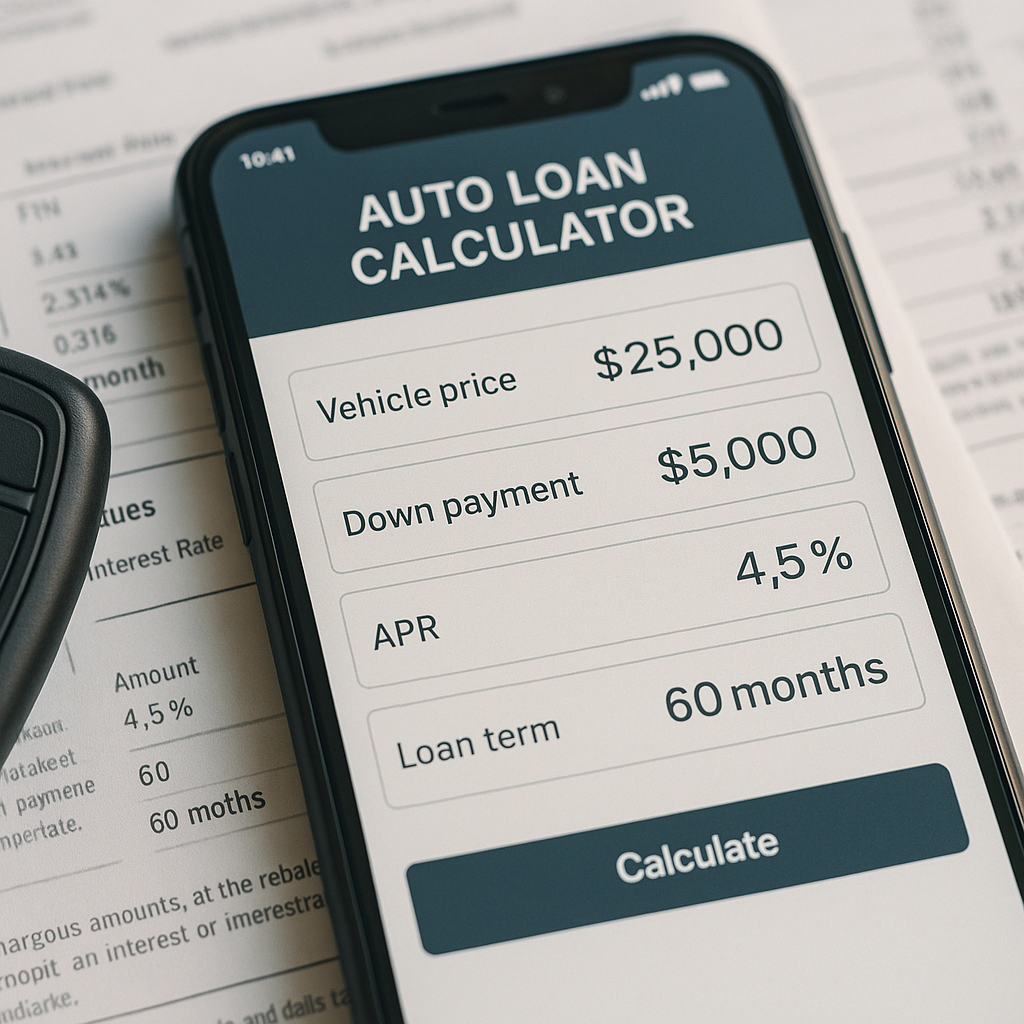Buying a car can be one of the most exciting yet financially complex decisions you’ll ever make. Whether you’re upgrading your ride, buying your first vehicle, or switching from leasing to owning, one thing is constant: you need to know what you can truly afford.
And that’s where a reliable auto loan calculator becomes your best friend.
With the cost of vehicles—and interest rates—on the rise, it’s more important than ever to understand the ins and outs of your financing options. This guide walks you through how to use an auto loan calculator, what features make one trustworthy, and how to apply the results to get the best car deal possible.
Table of contents
Understand Your Auto Loan Before You Sign
Too often, car buyers walk into a dealership with only a rough idea of what they can spend each month. Sales reps know this and may offer to “get your monthly payment down” by stretching the loan term or skipping over key details like APR or total interest paid.
Don’t fall into that trap.
An auto loan calculator lets you simulate your financing situation in advance. You can plug in:
- The car’s purchase price
- Your down payment
- Interest rate (APR)
- Loan term (in months)
- Trade-in value
- Sales tax and fees (if the calculator allows)
In seconds, you’ll see your monthly payment and the total cost of the loan, including how much you’ll pay in interest over time.
That’s valuable insight—especially when you’re comparing multiple vehicles or financing offers. By understanding how each factor affects your payment and total cost, you can confidently say “yes” or “no” to offers that come your way.
Example:
Imagine you’re financing $30,000 at 6.5% APR over 72 months.
Your monthly payment: ~$507
Total interest: ~$6,500
Total loan cost: ~$36,500
What if you switch to 60 months?
Monthly payment: ~$586
Total interest: ~$5,200
Total loan cost: ~$35,200
That’s a $1,300 savings just by adjusting the term—and it’s all visible in the calculator.
Key Features to Look For in an Auto Loan Calculator
Let’s face it: there are dozens of car loan calculators online. But not all of them offer the same accuracy or functionality. If you want real insights—not just a monthly number—look for these key features:
1. Loan Breakdown
A high-quality calculator should show how each monthly payment is divided between principal and interest. This breakdown helps you see how quickly you’re building equity in your vehicle.
2. Amortization Schedule
This is a month-by-month table showing your balance, payment breakdown, and cumulative interest. It’s especially helpful for people considering extra payments or early payoff strategies.
3. APR-Based Calculations
Some basic calculators only use “interest rate” and ignore fees. A true APR-based model includes lender fees and gives a more realistic estimate.
4. Taxes and Fees Input
A good calculator lets you add in your local sales tax and estimated dealer fees. This prevents underestimating your loan amount or monthly payments.
5. Trade-In Value and Down Payment Options
These two inputs reduce your total loan amount. Any calculator worth using should allow you to enter both.
6. Extra Payments Option
Advanced calculators may let you add monthly or one-time extra payments to see how much interest you’d save and how much faster you could pay off the loan.
Pro Tip: Bookmark one or two calculators you trust. Revisit them when interest rates change or your budget shifts.
How to Use a Car Loan Calculator Like a Pro
Using an auto loan calculator might seem simple on the surface, but understanding the numbers behind the inputs can make you a smarter shopper. Let’s walk through each step in detail:
Step 1: Enter the Vehicle Price
Include the full sale price of the car you’re considering—before taxes and fees. If you’re adding extended warranties or accessories, include those too.
Step 2: Input Your Down Payment
This could be cash savings or a credit card advance (though the latter is riskier). A bigger down payment usually results in better loan terms and less total interest paid.
Step 3: Add Trade-In Value
If you’re trading in your current vehicle, subtract its value from the loan total. Make sure to deduct any remaining loan balance on the trade-in from its value.
Step 4: Choose Loan Term (in Months)
Common terms are 36, 48, 60, 72, or even 84 months. Shorter terms usually mean higher monthly payments but lower total interest costs.
Step 5: Enter APR (Interest Rate)
Use your pre-approved rate, or estimate based on your credit score. If unsure, use a range of scenarios—like 5%, 7%, and 9%—to see how payments change.
Step 6: Add Estimated Taxes and Fees
Some calculators have separate fields for this. If not, add these amounts to the total loan before entering it.
Step 7: Review Monthly Payment and Loan Summary
Check your monthly payment and total repayment amount. If it’s too high, adjust the inputs. Try a higher down payment or a shorter term.
Step 8: Evaluate Amortization Table (if available)
This helps you understand when most of your payment goes to interest vs. principal—and when equity starts to build.
Tips to Secure the Best Auto Loan Rates
A calculator helps you visualize your options. But securing a great interest rate requires preparation, timing, and negotiation.
Here are actionable tips to help you qualify for better rates and loan terms:
1. Check and Improve Your Credit Score
Credit scores have a big impact on your rate. Before you apply:
- Check your score through free services like Credit Karma
- Dispute errors on your credit report
- Pay down high-balance cards
- Avoid opening new accounts 1–2 months before applying
Even a 30–50 point boost can lower your APR significantly.
2. Get Preapproved from Banks or Credit Unions
Don’t rely on dealership financing first. Banks and credit unions often offer lower APRs and more transparent terms. Preapproval also gives you leverage at the dealership.
3. Compare Multiple Lenders
Use online platforms to compare loan terms side-by-side. Look at:
- APR
- Monthly payment
- Total interest
- Loan fees
- Early payoff penalties
4. Choose a Shorter Term if Possible
While longer terms reduce your monthly payment, they increase interest paid. Try to stay under 60 months if your budget allows.
5. Avoid Unnecessary Add-Ons
GAP insurance, paint protection, and extended warranties are often marked up at dealerships. Decline anything you don’t need—or shop for it separately.
6. Make a Larger Down Payment
Even $500–$1,000 extra can shave off months of payments and reduce your interest burden.
7. Use the Calculator to Spot “Payment Packing”
Dealers may focus on “monthly affordability” and hide costs in the payment. Your calculator lets you reverse-engineer what the deal really costs you over time.
The Role of Auto Loan Calculators in Smart Car Buying
A reliable auto loan calculator isn’t just a nice-to-have tool—it’s essential if you want to buy smart. Here’s why:
Informed Budgeting
You’ll know how much car you can afford before falling in love with something beyond your means.
Interest Cost Awareness
Seeing how much interest you’ll pay over time helps avoid bad loan offers.
Scenario Comparison
Try “what-if” situations: What if I put down more money? What if I choose a 48-month loan? The calculator makes this easy.
Avoid Overpayment
A well-informed buyer is less likely to agree to bad terms, useless add-ons, or hidden fees.
Stronger Negotiation Power
When you walk into the dealership knowing your numbers, you’re more likely to walk out with a fair deal.
Frequently Asked Questions (FAQs)
1. How accurate is an auto loan calculator?
Most calculators provide strong estimates when you enter accurate data. Keep in mind, actual lender terms can vary based on your credit score, income verification, and regional taxes or fees.
2. What interest rate should I use in the calculator?
Use your lender’s quoted APR if available. Otherwise, estimate based on your credit score:
| Credit Score Range | Estimated APR (New Car) |
| 750+ | 4%–5% |
| 700–749 | 5%–7% |
| 640–699 | 7%–10% |
| Below 640 | 10%–15% or higher |
3. Can I include taxes and fees in the calculator?
Yes, if the calculator has fields for this. If not, add an estimated amount (often 6–10% of the car price) to the total loan amount before entering it.
4. How does a trade-in or down payment affect my results?
Both reduce the loan amount. That means lower monthly payments, less interest paid, and possibly qualifying for better financing terms.
5. Does the calculator show total interest paid over the loan?
The best calculators do. If yours doesn’t, consider using one that offers a full amortization schedule or summary of total costs.
Final Thoughts
Auto loan calculators are one of the most underused but powerful tools in the car-buying process. They give you the numbers you need to compare offers, budget properly, and avoid financial surprises.
Here’s what we recommend:
- Use the calculator before setting foot in a dealership
- Get preapproved from a trusted lender
- Compare interest rates, not just monthly payments
- Use your trade-in or down payment to reduce loan costs
- Consider short loan terms for maximum savings
Ultimately, buying a car should be exciting—not stressful. With a reliable auto loan calculator by your side, you’re not just guessing—you’re making smart, informed decisions every step of the way.



